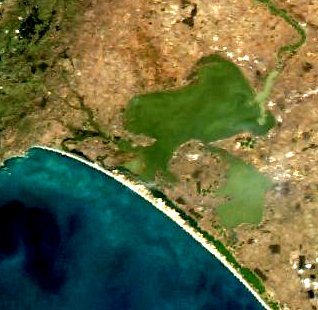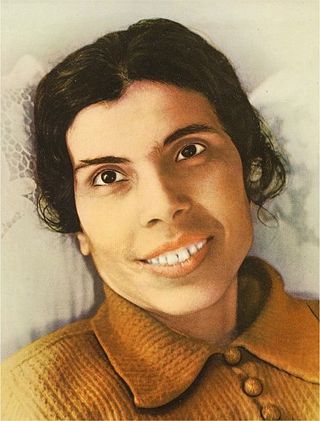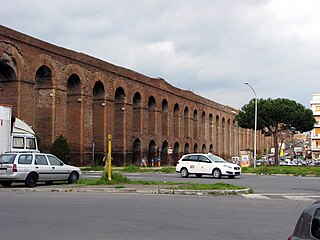Related Research Articles

The Domus Aurea was a vast landscaped complex built by the Emperor Nero largely on the Oppian Hill in the heart of ancient Rome after the great fire in 64 AD had destroyed a large part of the city.

The Golden Legend is a collection of 153 hagiographies by Jacobus de Voragine that was widely read in Europe during the Late Middle Ages. More than a thousand manuscripts of the text have survived. It was likely compiled around 1259–1266, although the text was added to over the centuries.

The Bibliotheca Alexandrina (BA) is a major library and cultural center on the shore of the Mediterranean Sea in Alexandria, Egypt. It is a commemoration of the Library of Alexandria, once one of the largest libraries worldwide, which was lost in antiquity. The idea of reviving the old library dates back to 1974 when a committee set up by Alexandria University selected a plot of land for its new library. Construction work began in 1995, and after some US$220 million had been spent, the complex was officially inaugurated on 16 October 2002. In 2009, the library received a donation of 500,000 books from the Bibliothèque nationale de France (BnF). The gift makes the Bibliotheca Alexandrina the sixth-largest Francophone library in the world.

The Lei Áurea, officialy Law No. 3,353 of 13 May 1888, is the law that abolished slavery in Brazil. It was signed by Isabel, Princess Imperial of Brazil (1846–1921), an opponent of slavery, who acted as regent to emperor Pedro II, who was in Europe.

Lake Alexandrina is a coastal freshwater lake located between the Fleurieu and Kangaroo Island and Murray and Mallee regions of South Australia, about 100 kilometres (62 mi) south-east of Adelaide. The lake adjoins the smaller Lake Albert and a coastal lagoon called The Coorong to its southeast, before draining into the Great Australian Bight via a short, narrow opening known as Murray Mouth.
The Muldjewangk is a water-creature in Ngarrindjeri mythology that inhabited the Murray River, particularly Lake Alexandrina. It was used as a deterrent for Aboriginal children who wished to play near the riverside after dark. Sometimes they are portrayed as evil merfolk, and other times as a gargantuan monster. Accounts are inconsistent as to whether there are many of the creatures, or a single "The Muldjewangk".

Alexandrina Council is a local government area in the Fleurieu and Kangaroo Island region of South Australia. The Alexandrina Council was formed on 1 July 1997 by the amalgamation of the District Council of Port Elliot and Goolwa, the District Council of Strathalbyn and a portion of the District Council of Willunga. The council is divided into five wards: Nangkita Kuitpo, Angas Bremer, Port Elliot Middleton, Strathalbyn and Goolwa Hindmarsh Island.
The District Council of Alexandrina was a local government area in rural South Australia from 1856 to 1888.

Alexandrina Maria da Costa, best known as Blessed Alexandrina of Balazar, was a Portuguese mystic and victim soul, member of the Association of Salesian Cooperators, who was born and died in Balazar. On 25 April 2004, she was declared blessed by Pope John Paul II who stated that "her secret to holiness was love for Christ".
Nicholas Myrepsos was a Byzantine physician known chiefly for his compendium on medical science which is still extant.

The Field Elm cultivar Ulmus minor 'Viminalis Aurea', probably a "golden" form of Ulmus minor 'Viminalis', was raised before 1866 by Egide Rosseels of Louvain, who was known to have supplied 'Viminalis'.
The Wych Elm cultivar Ulmus glabra 'Latifolia Aurea' was listed by Schelle in Beissner et al, Handbuch der Laubholz-Benennung (1903), as Ulmus glabraMillerlatifolia aurea, but without description. In the Netherlands in the late 19th and early 20th centuries, however, Ulmus montana latifolia aurea was a synonym of the wych cultivar 'Lutescens', and Green reclassified Schelle's 'Latifolia aurea' as a form of U. glabraHudson.

Áurea is a municipality in the state of Rio Grande do Sul, Brazil. As of 2020, the estimated population was 3,535.

Ficus aurea, commonly known as the Florida strangler fig, golden fig, or higuerón, is a tree in the family Moraceae that is native to the U.S. state of Florida, the northern and western Caribbean, southern Mexico and Central America south to Panama. The specific epithet aurea was applied by English botanist Thomas Nuttall who described the species in 1846.

The Aqua Alexandrina was a Roman aqueduct located in the city of Rome. The 22.4 km long aqueduct carried water from Pantano Borghese to the Baths of Alexander on the Campus Martius. It remained in use from the 3rd to the 8th century AD.
Aurea, golden in Latin, may refer to:

Alexandrina Cabral Barbosa is a handballer who plays as a left back for Brest Bretagne Handball. Born in Portugal, she represents the Spain women's national team.

Aurea Aguilar is a Mexican multimedia visual artist whose work has been recognized with membership in Mexico's Salón de la Plástica Mexicana.

The County of Hindmarsh is one of the 49 cadastral counties of South Australia. It was proclaimed by Governor George Grey in 1842 and named for Governor John Hindmarsh.
The Bibliotheca Alexandrina’s 100,Greatest Egyptian Films is a list compiled in November 2006 by a committee formed by Bibliotheca Alexandrina, which includes Ahmed El Hadari as the committee head, with the membership of Samir Farid and Kamal Ramzi.
References
- ↑ Duffin, C.J.; Moody, R.T.J.; Gardner-Thorpe, C. (10 December 2013). A History of Geology and Medicine. Geological Society of London. p. 176. ISBN 9781862393561 . Retrieved 19 August 2017.
- ↑ "History of Science and Technology - Collection - UWDC - UW-Madison Libraries".